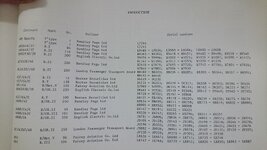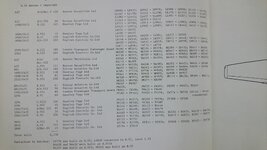33k in the air
Staff Sergeant
- 1,356
- Jan 31, 2021
Yes, a new serial number thread. As before, if anyone has additional information to add to what's presented here, please post it. 
Four sources were used: Halifax Special by Bruce Robertson (Ian Allan Ltd, 1990), Halifax Second to None by Victor Bingham (Airlife Publishing, 1986), Halifax: From Front-Line Bomber to Post-War Transport by Aeroplane Monthly (Kelsey Publishing, 2013), and The Handley Page Halifax — B.III, VI, VII by Philip J.R. Moyes (Profile Publications, 1965). These source will be referred to as BR, VB, AM, and PM, respectively. Note that VB and PB are missing some serial number batches as compared to BR.
The serials were entered into a spreadsheet along with the aircraft Mark according to each source. Any conflicts between sources were highlighted, and the Form 78 Aircraft Movement Cards found at the Bomber Command History website were used as the conflict resolution.
Most serials were in agreement, with far fewer conflicts that was the case with the Wellington. Below are the Halifax serial number/aircraft mark discrepancies which were found.
LV776 (1 aircraft)
BR has this as Mk 6
VB, AM, and PM has this as Mk 3
Form 78 has this as Mk 6
NA310 (1 aircraft)
BR, VB, and AM has this as Mk 7
Form 78 has this as Mk 3
NA428 (1 aircraft)
NA452 (1 aircraft)
BR has these as Mk 3
VB and AM has these as Mk 7
Form 78 has these as Mk 7
NP681–NP714 (34 aircraft)
BR, VB, and PM has these as Mk 7
AM has these as Mk 6
Form 78 has these as Mk 7
NP715 (1 aircraft)
BR, AM, and PM has this as Mk 6
VB has this as Mk 7
Form 78 has this as Mk 6
NP716–NP723 (8 aircraft)
NP736–NP747 (12 aircraft)
BR, VB, and PM has these as Mk 7
AM has these as Mk 6
Form 78 has these as Mk 7
NP748 (1 aircraft)
BR and VB has this as Mk 7
AM and PM has this as Mk 6
Form 78 has this as Mk 6
NP749–NP751 (3 aircraft)
BR, VB, and PM has these as Mk 7
AM has these as Mk 6
Form 78 has these as Mk 7
NP752–NP753 (2 aircraft)
BR, AM, and PM has these as Mk 6
VB has these as Mk 7
Form 78 has these as Mk 6
NP754–NP757 (4 aircraft)
BR, VB, and PM has these as Mk 7
AM has these as Mk 6
Form 78 has these as Mk 7
NP758 (1 aircraft)
BR and VB has this as Mk 7
AM and PM has this as Mk 6
Form 78 has this as Mk 6
NP759 (1 aircraft)
BR, VB, and PM has this as Mk 7
AM has this as Mk 6
Form 78 has this as Mk 7
NP760 (1 aircraft)
BR and VB has this as Mk 7
AM and PM has this as Mk 6
Form 78 has this as Mk 6
NP761 (1 aircraft)
BR, VB, and PM has these as Mk 7
AM has these as Mk 6
Form 78 has these as Mk 7
NP762–NP767 (6 aircraft)
BR and VB has these as Mk 7
AM and PM has these as Mk 6
Form 78 has these as Mk 6
NP768–NP781 (14 aircraft)
NP793–NP820 (28 aircraft)
BR, VB, and PM has these as Mk 7
AM has these as Mk 6
Form 78 has these as Mk 7
NP821 (1 aircraft)
BR, AM, and PM has this as Mk 6
VB has this as Mk 7
Form 78 has this as Mk 6
PN208 (1 aircraft)
BR and AM has this as Mk 7
VB and PM has this as Mk 3
Form 78 has this as Mk 7
PN344 (1 aircraft)
VB has this as Mk 7
BR, AM, PM, and Form 78 do not have this serial number
PP225 (1 aircraft)
BR has this as Mk 6
VB and AM has this as Mk 8
Form 78 has this as Mk 8
PP244–PP247 (4 aircraft)
BR and AM has these as Mk 8
VB has these as Mk 7
Form 78 has these as Mk 8
PP277 (1 aircraft)
BR has this as Mk 7
VB and AM has this as Mk 8
Form 78 has this as Mk 8
TW774–TW796 (23 aircraft)
BR, VB, and AM has these as Mk 6
PM has these as Mk 7
Form 78 has these as Mk 6
BR has the total production numbers for each variant. Below is what that source gives along with the revised count factoring in the discrepancy corrections listed above.
If anyone has any additional information or references they'd like to share, please do share them.
Four sources were used: Halifax Special by Bruce Robertson (Ian Allan Ltd, 1990), Halifax Second to None by Victor Bingham (Airlife Publishing, 1986), Halifax: From Front-Line Bomber to Post-War Transport by Aeroplane Monthly (Kelsey Publishing, 2013), and The Handley Page Halifax — B.III, VI, VII by Philip J.R. Moyes (Profile Publications, 1965). These source will be referred to as BR, VB, AM, and PM, respectively. Note that VB and PB are missing some serial number batches as compared to BR.
The serials were entered into a spreadsheet along with the aircraft Mark according to each source. Any conflicts between sources were highlighted, and the Form 78 Aircraft Movement Cards found at the Bomber Command History website were used as the conflict resolution.
Most serials were in agreement, with far fewer conflicts that was the case with the Wellington. Below are the Halifax serial number/aircraft mark discrepancies which were found.
LV776 (1 aircraft)
BR has this as Mk 6
VB, AM, and PM has this as Mk 3
Form 78 has this as Mk 6
NA310 (1 aircraft)
BR, VB, and AM has this as Mk 7
Form 78 has this as Mk 3
NA428 (1 aircraft)
NA452 (1 aircraft)
BR has these as Mk 3
VB and AM has these as Mk 7
Form 78 has these as Mk 7
NP681–NP714 (34 aircraft)
BR, VB, and PM has these as Mk 7
AM has these as Mk 6
Form 78 has these as Mk 7
NP715 (1 aircraft)
BR, AM, and PM has this as Mk 6
VB has this as Mk 7
Form 78 has this as Mk 6
NP716–NP723 (8 aircraft)
NP736–NP747 (12 aircraft)
BR, VB, and PM has these as Mk 7
AM has these as Mk 6
Form 78 has these as Mk 7
NP748 (1 aircraft)
BR and VB has this as Mk 7
AM and PM has this as Mk 6
Form 78 has this as Mk 6
NP749–NP751 (3 aircraft)
BR, VB, and PM has these as Mk 7
AM has these as Mk 6
Form 78 has these as Mk 7
NP752–NP753 (2 aircraft)
BR, AM, and PM has these as Mk 6
VB has these as Mk 7
Form 78 has these as Mk 6
NP754–NP757 (4 aircraft)
BR, VB, and PM has these as Mk 7
AM has these as Mk 6
Form 78 has these as Mk 7
NP758 (1 aircraft)
BR and VB has this as Mk 7
AM and PM has this as Mk 6
Form 78 has this as Mk 6
NP759 (1 aircraft)
BR, VB, and PM has this as Mk 7
AM has this as Mk 6
Form 78 has this as Mk 7
NP760 (1 aircraft)
BR and VB has this as Mk 7
AM and PM has this as Mk 6
Form 78 has this as Mk 6
NP761 (1 aircraft)
BR, VB, and PM has these as Mk 7
AM has these as Mk 6
Form 78 has these as Mk 7
NP762–NP767 (6 aircraft)
BR and VB has these as Mk 7
AM and PM has these as Mk 6
Form 78 has these as Mk 6
NP768–NP781 (14 aircraft)
NP793–NP820 (28 aircraft)
BR, VB, and PM has these as Mk 7
AM has these as Mk 6
Form 78 has these as Mk 7
NP821 (1 aircraft)
BR, AM, and PM has this as Mk 6
VB has this as Mk 7
Form 78 has this as Mk 6
PN208 (1 aircraft)
BR and AM has this as Mk 7
VB and PM has this as Mk 3
Form 78 has this as Mk 7
PN344 (1 aircraft)
VB has this as Mk 7
BR, AM, PM, and Form 78 do not have this serial number
PP225 (1 aircraft)
BR has this as Mk 6
VB and AM has this as Mk 8
Form 78 has this as Mk 8
PP244–PP247 (4 aircraft)
BR and AM has these as Mk 8
VB has these as Mk 7
Form 78 has these as Mk 8
PP277 (1 aircraft)
BR has this as Mk 7
VB and AM has this as Mk 8
Form 78 has this as Mk 8
TW774–TW796 (23 aircraft)
BR, VB, and AM has these as Mk 6
PM has these as Mk 7
Form 78 has these as Mk 6
BR has the total production numbers for each variant. Below is what that source gives along with the revised count factoring in the discrepancy corrections listed above.
Code:
BR Rev
2 2 Prototypes
84 84 Mk 1
1,977 1,977 Mk 2
2,091 2,090 Mk 3
904 904 Mk 5
473 481 Mk 6
404 395 Mk 7
98 100 Mk 8
145 145 Mk 9
6,178 6,178 TotalIf anyone has any additional information or references they'd like to share, please do share them.


